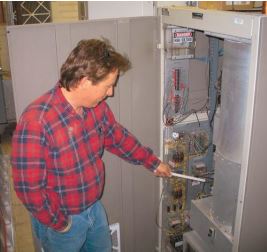Staying Safe When You Must Work Alone

[July 2011] We do hear a lot about safety. But when we are busy – especially when a station is off the air – it is easy to get sloppy about safety. Jerry Mathis puts a focus on things we can do to be safer.
I was saddened recently, learning of the August 2010 death of Jerry Campbell, a local engineer here in Mississippi. After reading the story of his demise, I was vividly reminded of just how easy it is to become a “Silent Key,” as the Hams put it.
The story is all the more stark because Jerry was not even working alone at the time of the accident – he had the station manager there with him – and yet he still died.
Working Alone
I never met Jerry Campbell although we did talk on the phone a few times. We shared two things. One was working on one particular radio station. And, like him, during most of my career I have worked alone at remote transmitter sites.
A radio engineer working alone is not unusual. Working in small-town radio for the most part you find two engineers just are not in the cards (or, more specifically, the budget). I had a few “close calls” some years ago. Fortunately, I learned from them and from reading the advice of my peers.
It is possible to work safely on transmitting equipment by yourself. No, I do not recommend it, but I understand that it is often necessary, and with today’s engineering budgets, it often is the only way the work will get done in most cases. Having a second person – even if it is a non-technical staffer or friend – is much preferable to working alone.
Staying Alive
Nevertheless, the reality is that most broadcast engineers will end up working alone at some point or other.
With that in mind, I am going to share some of my tips and methods for surviving while working alone. I hope that these will help you in avoiding a tragic outcome of your own.
1. Approach any new transmitter installation as you would a rattlesnake.
Both are equally deadly!
Your first visit to a new jobsite should put you on full precautionary alert. You have no familiarity with the equipment you are about to get intimately acquainted with; and even if it is a standard, respected-name-brand unit, you have no idea what has previously been done to it. So take every precaution when you first open it up.
2. Turn off the transmitter. Kill the power to the box. Kill all the power to the box!

There are some transmitters that do require multiple power sources. I know; I maintain one: a Harris FM-10K. There is a 3-phase power source, and a single-phase power source. In other words, two different circuit breakers.
On an unfamiliar site, watch for this – they may not all be labeled.
3. Open the door(s) to the equipment. Look carefully inside.
Use a light if needed.
Your first look should not be to find why the equipment is not working – you must first look for any hazardous-looking wiring and components.
A good start is to look at all the large power resistors. Tube-type transmitters usually have a number of these used as high-voltage bleeder resistors. If you see any burned or broken power resistors, immediately be suspicious that deadly high voltage is still present in the transmitter.
Now understand, even if there are no burned or broken resistors, there may still be high voltage present. But the presence of obviously defective parts makes this much more likely.
Also, it has been my experience that practically all transmitters have a high-voltage metering circuit that will indicate the high voltage reading even when the transmitter is turned off and powered down. This is one obvious thing you should also check. I used to rely on such an indication as proof – until I came across a transmitter where the high voltage metering circuit was defective.
The Moral: Everything is guilty until proven innocent!
The Stick of Life
4. Now is the time to look for the shorting stick … also known as the “Jesus stick” (at the end of the article you will see why I mention this).
When you find it, pull it from its mounting place and inspect it. Check especially the cable going from the stick to the place it fastens onto the transmitter.
- Is the cable of sufficient gauge?
- Is it fastened properly to the shorting stick metallic element?
- Is it fastened properly and securely to the transmitter frame/chassis?
- Is it frayed significantly anywhere?
- If you have any doubts about the integrity of the shorting stick assembly, verify its operation now, before attempting to use it.
Remember: An inoperative shorting stick is worse than useless. It will give you a false sense of security that could lead to your death!
5. Once you are satisfied the shorting stick is in good condition, start using it.
Start with all high-voltage components, such as the high-voltage transformer, all cabinet-mounted high-voltage capacitors, and the inductors/reactors. With one hand in a pocket, touch all terminals of all these devices.

Keeping one hand in a pocket is safer
If you are going to be working on the power tubes, touch all of the terminals in this area as well.
Finally, touch any power line terminals you can see. If there was a power source you did not find at the electrical panel, you might find it now.
6. Keep your guard up!
At this point, you should be safe to start inspecting and repairing the transmitter. Just remember to keep your wits and common sense about you.
If you come across any wiring, circuit, or component that gives you doubts, reach again for the shorting stick.
It is easy to rationalize that you have already checked everything, Just remember it only takes one mistake to do you in.
An Extra Minute of Airtime is Not Worth a Life
7. If you are dead-dog tired, do not work!
Not even if you have someone with you.
Yes, I know we often put in long hours, and being tired goes with the job. But if you are so tired that all you can think about is getting some zzz’s, then go do that.
When your mind is not on what you are doing, just like texting while driving, you are far more likely to make a fatal error in judgment. Now I understand that this can cause problems with station Management, especially if you are their employee. But if they respect you at all, they should understand.
This is a life-safety issue. If you die on the job, believe me – questions will be asked and an investigation made. Management, if they understand this, does not want that any more than you want to die. Of course, that just might be a little late for you, personally.
If you are a contract engineer, the issue is easier to handle: you will get it fixed when you can. No client is worth your life.
8. If you leave the job for any significant amount of time, re-check the transmitter before resuming work.
This may seem a waste of time, even when working on a new job. But this is apparently the cause of what happened to Jerry Campbell.
While checking the transmitter, he turned the power back on. At some point, he took a smoke break.
Upon returning, he apparently forgot that he had turned on the power.
He then leaned into the transmitter and put his arm on top of the HV transformer, coming in contact with some of the wiring terminals. His other hand touched ground. It was hot and he was sweaty, making his skin all that much more conductive.
The current through his chest cavity killed him. A simple error cost a life.
However you go about doing it – lights, a noise signal, a non-tech person – make sure you are aware of whether the power is on or off every time you approach a transmitter.
9. Complacency.
Complacency is the most dangerous part of working alone!
When you do all the work at a site for a long time, it is natural for you eventually to become familiar with the equipment. One result is that you might no longer do all the checks you did the first time you saw the transmitter.
To some degree, this is OK. For instance, you do learn where all the power disconnects are for the transmitter.
But you must remember that each new problem that develops with the transmitter presents the possibility of different component failures that create new safety hazards.
For instance, high-voltage bleeder resistors tend to go bad over time. If one opens up, and you do not know it, you could be electrocuted because you did not use the shorting stick “just that one time.”
Complacency and carelessness go hand in hand. Because the shorting stick never drew an arc the first 99 times you used it, does not mean it will not do so on the 100th time.
10. Read the documentation of the previous engineer’s work – and document yours.
On your first visit, especially if you are there to get the station back on the air, you will not necessarily do this. But if you have the time, and will be maintaining this site for the foreseeable future, take the time to sit down and see what has gone on before you arrived on the scene.
Knowing the previous problems, and what was done to solve them, will make your work easier. Hopefully, things like circuit modifications will be documented. And be sure to return the favor and thoroughly document your work, for the benefit of those who will come after you.
11. Make sure someone responsible knows where you are going, when you expect to arrive there, when you expect to return, and what to do if things go off the rails.
That way, if something does happen to you and you cannot reach out for yourself, someone will check on you. Even better is to have a “check-in” system, where you call or are called every hour.
This is a most basic safety practice but, unfortunately, seldom followed.
It is Only a Relative Safety
To repeat – and this is a critically important point – please understand that I am not saying that working alone can ever be made totally safe.
What I am offering are some tips and practices that, if followed, will lessen your chance of being injured or killed while doing so.
I have been working in radio for over 40 years now, about 35 of them as an engineer. And I hope to continue safely until I retire.
What I do not want is to have the epitaph on my headstone to read: “Jesus, he’s come to see you, and explain why he didn’t use Your stick!”
– – –
Jerry Mathis is currently an engineer working for Clear Channel Radio and Urban Radio Broadcasting. He resides in Tupelo, MS. He can be reached at thebeaver32@gmail.com
